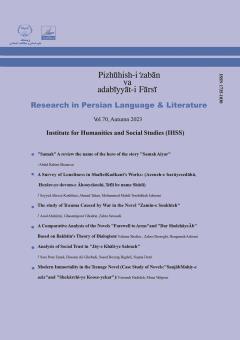Political Novel is one the fiction types of Persian literature with special features that is distinct from other movements of contemporary story writing. Due to its uniqueness of these kinds of stories, and their close interaction with society and social and political e
More
Political Novel is one the fiction types of Persian literature with special features that is distinct from other movements of contemporary story writing. Due to its uniqueness of these kinds of stories, and their close interaction with society and social and political events, critical discourse analysis (CDA) method is an appropriate approach in analyzing this kind of fiction. This approach focuses on form and meaning and in analyzing literary texts, it focuses also on different cultural, social, and political factors that are effective in text formation; it is for this reason that CDA theoreticians maintain that we do not deal just with lexical elements forming sentences as the main criteria for explaining meaning, that is co-text, but also beyond that, factors outside of text, i.e. situational, cultural, social and so on context. Norman Fairclough is a CDA theoretician who reviews texts in three levels, descriptive, interpretive and expressive. This method of analyzing is so useful in discovering and expressing intellectual ideas of authors and their political and social approaches. Theoretical framework of this research is based on Fairclough CDA. Research method is descriptive-analytic and it tries, based on CDA, to reflect on and reread “My Homeland's Secrets” Novel by Reza Barahini which is one the most brilliant political novels after Islamic Revolution, and reviews and analyzes main political events in Iran focusing on psychological issues like personalities and brilliant elements in it like title semiotics, images and descriptions, story’s characters (agent, passive and narrator), type of narration, design and dominant theme of story and … . Results show that this novel, as a literary text, is in interaction with Fairclough method of Discoursal action and social action and dominant hegemony and has close affinities with hegemonic discourse of three decade ago.
Manuscript profile


